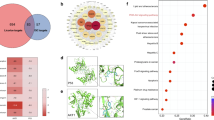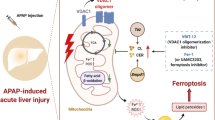Abstract
Purpose
The present study, conducted in rats, investigated whether propofol attenuates lipopolysaccharide (LPS)-triggered liver dysfunction via regulation of tumor necrosis factor (TNF)-α production in activated Kupffer cells.
Methods
Rats received LPS (500 μg/kg) under Urethane™ sedation (1 g/kg) in combination with propofol (5 mg/kg/h) or Intralipid™ from 1 h before to 6 h after LPS administration. Some rats were treated with 10 mg/kg gadolinium chloride (GdCl3) to induce Kupffer cell depletion. The serum levels of alanine aminotransferase (ALT) and aspartate aminotransferase (AST), TNF-α mRNA and protein expression, caspase-3 activation and apoptosis were evaluated in hepatocytes. Immunofluorescence staining revealed expression of the pan-macrophage marker CD68 as well as TNF-α in Kupffer cells.
Results
ALT and AST serum levels increased approximately four-fold in LPS-exposed rats compared with Intralipid™-treated rats at 6 h after LPS administration, whereas propofol and GdCl3 reduced the LPS-induced increases. LPS simultaneously augmented TNF-α expression in Kupffer cells, followed by increased caspase-3 activity and apoptosis in hepatocytes. Immunofluorescence staining and immunoblotting assay showed that TNF-α expression in Kupffer cells was inhibited by propofol and GdCl3, resulting in a reduction of caspase-3 activity and apoptosis in LPS-treated rat hepatocytes.
Conclusions
Propofol (5 mg/kg/h) attenuated LPS-triggered liver dysfunction via inhibition of TNF-α production in activated Kupffer cells. These results suggest that propofol is capable of inhibiting inflammation-induced liver dysfunction in vivo.




Similar content being viewed by others
References
Bilzer M, Roggel F, Gerbes AL. Role of Kupffer cells in host defense and liver disease. Liver Int. 2006;26:1175–86.
Kolios G, Valatas V, Kouroumalis E. Role of Kupffer cells in the pathogenesis of the liver disease. World J Gastroenterol. 2006;12:7413–20.
Hewett JA, Roth RA. Hepatic and extrahepatic pathobiology of bacterial lipopolisaccharides. Pharmacol Rev. 1993;4:381–404.
Paik YH, Schwabe RF, Bataller R, Russo MP, Jobin C, Brenner DA. Toll-like receptor 4 mediates inflammatory signaling by bacterial lipopolysaccharide in human hepatic stellate cells. Hepatology. 2003;37:1043–55.
Streetz K, Leifeld L, Grundmann D, Ramakers J, Eckert K, Spengler U, Brenner D, Manns M, Trautwein C. Tumor necrosis factor alpha in the pathogenesis of human and murine fulminant hepatic failure. Gastroenterology. 2000;119:446–60.
Papadakis KA, Targan SR. Tumor necrosis factor: biology and therapeutic inhibitors. Gastroenterology. 2000;119:1148–57.
Wang H, Xue Z, Wang Q, Feng X, Shen Z. Propofol protects hepatic L02 cells from hydrogen peroxide-induced apoptosis via activation of extracellular signal-regulated kinases pathway. Anesth Analg. 2008;107:534–40.
Navapurkar VU, Skepper JN, Jones JG, Menon DK. Propofol preserves the viability of isolated rat hepatocyte suspensions under an oxidant stress. Anesth Analg. 1998;87:1152–7.
Sung E-G, Jee D, Song I-H, Kim H-S, Bae JH, Park S-H. Propofol attenuates Kupffer cell activation during hypoxia-reoxygenation. Can J Anesth. 2005;52:921–6.
Zhao G, Ma H, Shen X, Xu G-F, Zhu Y-L, Chen B, Tie R, Qu P, Lv Y, Zhang H, Yu J. Role of glycogen synthase kinase 3β in protective effect of propofol against hepatic ischemia–reperfusion injury. J Surg Res. 2013;185:388–98.
Kostopanagiotou GG, Grypioti AD, Matsota P, Mykoniatis MG, Demopoulos CA, Papadopoulou-Daifoti Z, Pandazi A. Acetaminophen-induced liver injury and oxidative stress: protective effect of propofol. Eur J Anaesthesiol. 2009;26:548–53.
Fan JH, Feng GG, Huang L, Tsunekawa K, Honda T, Katano Y, Hirooka Y, Goto H, Kandatsu N, Ando K, Fujiwara Y, Koide T, Okada S, Ishikawa N. Role of naofen in apoptosis of hepatocytes induced by lipopolysaccharide through mitochondrial signaling in rats. Hepatol Res. 2012;42:696–705.
Bruells CS, Maes K, Rossaint R, Thomas D, Cielen N, Bergs I, Bleilevens C, Weis J, Gayan-Ramirez G. Sedation using propofol induces similar diaphragm dysfunction and atrophy during spontaneous breathing and mechanical ventilation in rats. Anesthesiology. 2014;120:665–72.
Rüttinger D, Vollmar B, Wanner GA, Messmer K. In vivo assessment of hepatic alterations following gadolinium chloride-induced Kupffer cell blockade. J Hepatol. 1996;25:960–7.
Brown AP, Harkema JR, Schultze AE, Roth RA, Ganey PE. Gadolinium chloride pretreatment protects against hepatic injury but predisposes the lungs to alveolitis after lipopolysaccharide administration. Shock. 1997;7:186–92.
Vollmar B, Rüttinger D, Wanner GA, Leiderer R, Menger MD. Modulation of kupffer cell activity by gadolinium chloride in endotoxemic rats. Shock. 1996;6:434–41.
Ding H, Peng R, Reed E, Li QQ. Effects of Kupffer cell inhibition on liver function and hepatocellular activity in mice. Int J Mol Med. 2003;12:549–57.
Feng GG, Li C, Huang L, Tsunekawa K, Sato Y, Fujiwara Y, Komatsu T, Honda T, Fan JH, Goto H, Koide T, Hasegawa T, Ishikawa N. Naofen, a novel WD40-repeat protein, mediates spontaneous and tumor necrosis factor-induced apoptosis. Biochem Biophys Res Commun. 2010;394:153–7.
Livak KJ, Schmittgen TD. Analysis of relative gene expression data using realtime quantitative PCR and the 2(−Delta Delta C(T)) method. Methods. 2001;25:402–8.
Tilg H. Cytokines and liver diseases. Can J Gastroenterol. 2001;15:661–8.
Hoebe KH, Witkamp RF, Fink-Gremmels J, Van Miert AS, Monshouwer M. Direct cell-to-cell contact between Kupffer cells and hepatocytes augments endotoxin-induced hepatic injury. Am J Physiol Gastrointest Liver Physiol. 2001;280:G720–8.
Streetz K, Leifeld L, Grundmann D, Ramakers J, Eckert K, Spengler U, Brenner D, Manns M, Trautwein C. Tumor necrosis factor alpha in the pathogenesis of human and murine fulminant hepatic failure. Gastroenterology. 2000;119:446–60.
Dubravec DB, Spriggs DR, Mannick JA, Rodrick ML. Circulating human peripheral blood granulocytes synthesize and secrete tumor necrosis factor alpha. Proc Natl Acad Sci USA. 1990;87:6758–61.
Kawakami T, Sato S, Suzuki K. Beneficial effect of cyclosporin A on acute hepatic injury induced by galactosamine and lipopolysaccharide in rats. Hepatol Res. 2000;18:284–97.
Nagano T, Kita T, Tanaka N. The immunocytochemical localization of tumour necrosis factor and leukotriene in the rat liver after treatment with lipopolysaccharide. Int J Exp Pathol. 1992;73:675–83.
Ohira H, Ueno T, Torimura T, Tanikawa K, Kasukawa R. Leukocyte adhesion molecules in the liver and plasma cytokine levels in endotoxin-induced rat liver injury. Scand J Gastroenterol. 1995;30:1027–35.
Wang X, Liu Y, Feng J. Experimental study on early liver injury and expressions of TNF-alpha mRNA in burn rats with endotoxemia. Chin J Traumatol. 1999;2:30–4.
Hamada E, Nishida T, Uchiyama Y, Nakamura J, Isahara K, Kazuo H, Huang TP, Momoi T, Ito T, Matsuda H. Activation of Kupffer cells and caspase-3 involved in rat hepatocyte apoptosis induced by endotoxin. J Hepatol. 1999;30:807–18.
Strauss O, Dunbar PR, Bartlett A, Phillips A. The immunophenotype of the antigen presenting cells of the mononuclear phagocyte system in the normal human liver-a systematic review. J Hepatol. 2015;62:458–68.
Hamada E, Nishida T, Uchiyama Y, Nakamura J, Isahara K, Kazuo H, Huang TP, Momoi T, Ito T, Matsuda H. Activation of Kupffer cells and caspase-3 involved in rat hepatocyte apoptosis induced by endotoxin. J Hepatol. 1999;30:807–18.
Morikawa A, Sugiyama T, Kato Y, Koide N, Jiang GZ, Takahashi K, Tamada Y, Yokochi T. Apoptotic cell death in the response of d-galactosamine-sensitized mice to lipopolysaccharide as an experimental endotoxic shock model. Infect Immun. 1996;64:734–8.
Fan JH, Feng GG, Huang L, Tang GD, Jiang HX, Xu J. Naofen promotes TNF-α-mediated apoptosis of hepatocytes by activating caspase-3 in lipopolysaccharide-treated rats. World J Gastroenterol. 2014;20:4963–71.
Acknowledgments
This work was supported in part by a Grant-in-Aid for Scientific Research (No. 23592689), a grant from the Strategic Research Foundation Grant-aided Project for Private Universities (S1101027) from the Ministry of Education, Culture, Sports, Science, and Technology, Japan (MEXT), JSPS KAKENHI Grant Number 15K10998, and a grant for Education and Research from the Aikeikai Foundation, Japan.
Author information
Authors and Affiliations
Corresponding author
Ethics declarations
Conflict of interest
The authors declare no conflict of interest.
About this article
Cite this article
Li, J., Kandatsu, N., Feng, GG. et al. Propofol reduces liver dysfunction caused by tumor necrosis factor-α production in Kupffer cells. J Anesth 30, 420–426 (2016). https://doi.org/10.1007/s00540-016-2145-x
Received:
Accepted:
Published:
Issue Date:
DOI: https://doi.org/10.1007/s00540-016-2145-x




